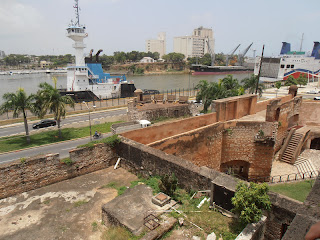The highway crosses one river on either side of San Pedro de Macorís. On the east side, the highway crosses the Rio Soco near its mouth. Along the bypass on the northwest side of the city, the highway crosses the Rio Iguamo on the Mauricio Báez Bridge. Completed in 2007, this is the longest cable-stayed bridge in the Carribean with a main span of 1,280 feet.
 |
| Soco River and Caribbean Sea |
 |
| Mauricio Báez Bridge over the Rio Soco |
 |
| Rio Ozama |
 |
| Our tour guide, Wellington, directs our attention to the former home of Hernán Cortés (now the French Embassy) |
 |
| Palacio Consistorial |
 |
| Christopher Columbus statue in Columbus Park |
The Cathedral of Santa Maria la Menor is the first cathedral in the New World. It was constructed between 1521 and 1540 using a mix of Gothic and Baroque architecture.
The National Pantheon of the Dominican Republic was originally built in the early 1700s as a Jesuit church. During the Haitian occupation of 1822 to 1844, theatrical events were staged to clandestinely promote independence. In 1956, it was remodeled to serve as a mausoleum for national heroes.
Built in 1753, one of the oldest sundials in the Americas stands outside the Museum of the Royal Houses. It has a morning and an afternoon dial. Both dials are visible from the former government offices and were used for official time keeping.
Alcázar de Colón or Columbus Palace is a two story residence and government office. It was ordered built by Diego Columbus, the elder son of Christopher. In 1509, Diego was named Governor of the Indies and Viceroy of the Indies in 1511. Construction began in 1510 and continued for two years. The building now houses a museum of colonial artifacts.
While the western balcony overlooks the Spanish Plaza, the eastern balcony overlooks the ancient fortified walls and the Rio Ozama.
Leaving the city, we detoured past the Columbus Lighthouse. The massive building in the shape of a cross was dedicated in 1992 to mark the 500th anniversary of Columbus' discovery of the New World.
One additional comment about the culture of the Dominican Republic is that I saw kids and young men playing baseball or walking to or from playing baseball everywhere I looked.
There is not an official site for the Ciudad Colonial. However, UNESCO has a site at http://whc.unesco.org/en/list/526/ and the government has a a site at http://www.dominicanrepublic.com/.
 |
| Side entrance of the Cathedral from Columbus Park |
 |
| North façade of the cathedral |
 |
| Interior of the cathedral |
The National Pantheon of the Dominican Republic was originally built in the early 1700s as a Jesuit church. During the Haitian occupation of 1822 to 1844, theatrical events were staged to clandestinely promote independence. In 1956, it was remodeled to serve as a mausoleum for national heroes.
 |
| Eternal Flame |
 |
| Wall of Heroes |
 |
| Entrance Hall |
 |
| Guards in dress uniforms at the National Pantheon |
Built in 1753, one of the oldest sundials in the Americas stands outside the Museum of the Royal Houses. It has a morning and an afternoon dial. Both dials are visible from the former government offices and were used for official time keeping.
 |
| Sundial |
 |
| Museo de las Casas Reales (Museum of the Royal Houses) |
Alcázar de Colón or Columbus Palace is a two story residence and government office. It was ordered built by Diego Columbus, the elder son of Christopher. In 1509, Diego was named Governor of the Indies and Viceroy of the Indies in 1511. Construction began in 1510 and continued for two years. The building now houses a museum of colonial artifacts.
 |
| Viceroyal Palace of Diego Columbus |
 |
| Portion of a tapestry in the Entrance Hall |
 |
| Servants dining room |
 |
| María's bedroom |
 |
| Living Room |
 |
| Diego's bedroom |
 |
| Diego's bedroom and balcony |
 |
| Diego's office |
 |
| Reception Hall |
 |
| Music Room |
 |
| Family Dining Room |
 |
| Balcony overlooking the Spanish Plaza |
While the western balcony overlooks the Spanish Plaza, the eastern balcony overlooks the ancient fortified walls and the Rio Ozama.
 |
| Avenida Francisco Alberto Caamaño Deño |
 |
| Old masonry fortifications |
 |
| Puente Flotante or Floating Bridge |
 |
| Foundations of a more elaborate fortification |
 |
| Modified fortifications to allow four-lane avenue |
 |
| Fortress wall |
 |
| Diego's balcony in Alcázar de Colón |
 |
| Puente Matías Ramón Mella |
Leaving the city, we detoured past the Columbus Lighthouse. The massive building in the shape of a cross was dedicated in 1992 to mark the 500th anniversary of Columbus' discovery of the New World.
 |
| Faro a Colón or Columbus Lighthouse |
 |
| Rio Dulce in La Romana from the ship |
One additional comment about the culture of the Dominican Republic is that I saw kids and young men playing baseball or walking to or from playing baseball everywhere I looked.
There is not an official site for the Ciudad Colonial. However, UNESCO has a site at http://whc.unesco.org/en/list/526/ and the government has a a site at http://www.dominicanrepublic.com/.



No comments:
Post a Comment